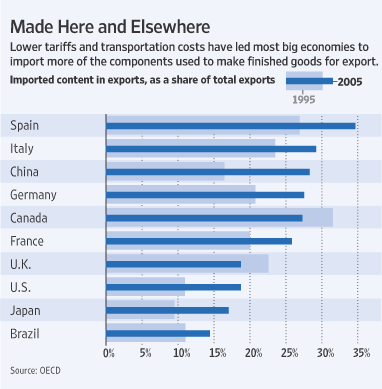
Source of graph: online version of the WSJ article quoted and cited below.
(p. A2) The WTO says world trade fell 12.2% in 2009. On Friday, the organization predicted that trade would bounce back sharply this year, rising 9.5%.
But these figures don’t tell the whole truth about trade.
According to some economists, trade in finished products–the things consumers actually buy, such as cars, computers and iPods–declined by much less than 12.2% last year. That is because as much as two-thirds of the value of goods that go into trade statistics represent intermediate parts, which are imported from other countries and used to make finished products that then get re-exported. Economists call this the “valued-added effect.” If the value of imported parts were stripped out, however, global trade would have declined by between 4% and around 8% last year, economists say.
By ignoring the multinational composition of goods, conventional trade data also make trade imbalances between some trading partners seem larger than they really are.
China imports a huge quantity of parts from places like Japan and South Korea, but when those components are assembled into finished goods and shipped to the U.S., all the pieces count as Chinese exports, inflating the U.S. trade imbalance with its most polarizing trade partner.
A study by the Sloan Foundation in 2007, for example, found that only $4 of an iPod that costs $150 to produce is made in China, even though the final assembly and export occurs in China. The remaining $146 represents parts imported to China. If only the value added by manufacturers in China were counted, the real U.S.-China trade deficit would be as much as 30% lower than last year’s gap of at $226.8 billion, according to a number of economists.
At the same time, the U.S. trade deficit with Japan would have been 25% higher than the $44.8 billion reported last year, because many goods that China and others export to the U.S. contain parts purchased in Japan.
For the full story, see:
JOHN W. MILLER. “THE NUMBERS GUY; Some Say Trade Numbers Don’t Deliver the Goods .” The Wall Street Journal (Sat., MARCH 27, 2010): A2.
